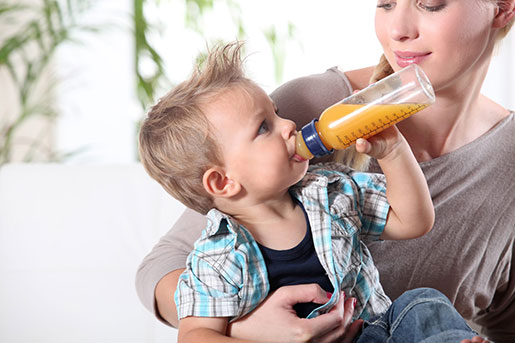 Babies experience numerous growth and development milestones, including the eruption of primary teeth, also known as baby teeth. These 20 teeth begin to grow in before a baby's first birthday and usually complete their eruption by the age of three. However, baby teeth face a potential threat called baby bottle tooth decay.
Babies experience numerous growth and development milestones, including the eruption of primary teeth, also known as baby teeth. These 20 teeth begin to grow in before a baby's first birthday and usually complete their eruption by the age of three. However, baby teeth face a potential threat called baby bottle tooth decay.
If your baby's first few baby teeth have already appeared, you need to understand some key points about baby bottle tooth decay, from its causes and symptoms to available strategies for treating or preventing the problem. The following questions and answers should give you the information you need to protect your little one's dental wellness.
What Causes Baby Bottle Tooth Decay?
True to its name, baby bottle tooth decay involves a form of tooth decay associated with bottle use. While drinking from a baby bottle doesn't automatically spell trouble, it can expose the upper front teeth to acids from the milk or juice in the bottle. These acids support cavity-causing bacteria while also damaging tooth enamel.
Baby bottle tooth decay most often occurs when parents leave a bottle of milk, juice, or some other sugary drink in the baby's crib. The baby may suck on the bottle throughout the night or fall asleep with the bottle still in their mouth at naptime. These behaviors result in regular, prolonged exposure to the acids and sugars in the bottle.
What Complications Can This Problem Create?
At any age, tooth decay and enamel damage pose obvious threats to dental health. Bacteria that breaks through the enamel can create serious toothaches, gum infections, and jawbone abscesses. These problems not only cause extraordinary pain and interfere with chewing, but they can also lead to systemic health problems.
Although baby teeth eventually make way for permanent teeth, you shouldn't think of them as unimportant to your child's long-term dental wellness. The eruption and spacing of these teeth help guide the permanent teeth into their preferred positions. Baby teeth lost to decay can raise the risk that your baby's permanent teeth might erupt incorrectly.
What Symptoms Indicate Baby Bottle Tooth Decay?
Early symptoms of baby bottle tooth decay can easily elude a parent's casual inspection. Look for subtle white discolorations around the gum line of your baby's top front teeth. Brown discoloration may indicate a cavity produced by baby bottle tooth decay. Your pediatric dentist can detect these early warning signs during a routine exam.
As baby bottle tooth decay progresses, the symptoms can grow more distressing. Your child may experience oral pain and swelling, bad breath, fever, and bleeding gums. These symptoms call for prompt evaluation, diagnosis, and treatment.
How Do Dentists Deal With This Condition?
Pediatric dentists can treat baby bottle tooth decay in a variety of ways. In the early stages of decay, fluoride treatments can restore a baby's tooth enamel. If your baby's dental alignment or condition presents special challenges, your dentist may recommend sealants. These plastic coatings offer extra protection against decay.
Severe cases of baby bottle tooth decay may require dental restoration. Permanent crowns can protect teeth suffering from weak, thin, or damaged enamel. Baby teeth with large cavities may get more benefit from metal crowns than from ordinary fillings. If an infection threatens neighboring teeth, the dentist may extract the diseased tooth.
How Can You Protect Your Baby's Teeth?
The first step in preventing baby bottle tooth decay involves watching what you put into that bottle. At naptime and bedtime, fill the bottle only with harmless water. After daytime feedings, use a clean cloth to wipe your baby's gums clean. Even during these times, you should avoid filling the baby bottle with juices or sugary drinks.
The choice of water for your baby's bottle can also make a difference. Use tap water if the water in your area contains fluoride. If you don't have access to fluoridated water, ask your dentist to recommend a fluoride supplement of some sort. You can also brush your child's baby teeth with a pea-sized amount of fluoride toothpaste.
The same smart choices that lower the risk of baby bottle tooth decay can serve your child equally well in later life. Avoid serving juice to your child, or dilute the juice with water and serve it only with meals. Teach your child the importance of brushing and flossing. Serve healthy snacks such as cheese and nuts instead of sweets.
Remember that baby bottle tooth decay can easily go unnoticed in its early stages. Fortunately, your pediatric dentist has the necessary skills and equipment to spot the problem in time to treat it. For this reason, you should schedule your baby's first checkup either within six months of the eruption of the first baby tooth or by your baby's first birthday.
When you want to keep your child's teeth and gums in good working order for many years to come, nothing beats the skill and expertise of a caring periodontal dentist. Dentistry for Children & Adolescents can provide critical exams, cleanings, treatments, and advice to help you achieve this goal. Contact any of our offices today.